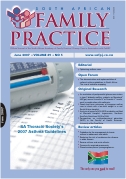Analysis of impact of HIV/AIDS upon deaths certified at Mosvold Hospital, Ingwavuma, Northern KwaZulu-Natal from January 2003 – June 2006 and possible effect of Anti-retroviral Roll-out Program
Keywords:
Acquired immunodeficiency syndrome, mortality, anti-retroviral, South Africa
Abstract
Background Mosvold Hospital is a government district hospital situated in northern KwaZulu-Natal, a province with an antenatal HIV prevalence of 39%. A previous study indicated that 45% of deaths certified at Mosvold Hospital were due to HIV/AIDS. The antiretroviral roll-out programme commenced at Mosvold Hospital on 16 September 2004. Method Data from deaths certified at Mosvold Hospital from 1 January 2003 to 31 December 2006 were analysed for trends in diagnosis and age at death. The period included 20 months prior to the start of the antiretroviral roll-out at the hospital in September 2004, and the first 28 months of the programme. Results Of the deaths between 2003 and 2006, 53% were certified as having HIV/AIDS as the underlying cause of death. Between 2003 and 2005 there was a significant reduction in the average age at death for males and females, with an increase in mortality in the zero to four years age group. In 2006 there was a significant increase in the average age at death of females compared to 2005, although this increase was not demonstrated to be due to an improvement in mortality from HIV/AIDS. Conclusions HIV/AIDS continues to be the dominant public health concern in the sub-district. To date, public health measures such as the antiretroviral roll-out programme cannot be demonstrated to have affected mortality from the disease.
Published
2007-06-01
Issue
Section
Original Research
By submitting manuscripts to SAFP, authors of original articles are assigning copyright to the South African Academy of Family Physicians. Copyright of review articles are assigned to the Publisher, Medpharm Publications (Pty) Ltd, unless otherwise specified. Authors may use their own work after publication without written permission, provided they acknowledge the original source. Individuals and academic institutions may freely copy and distribute articles published in SAFP for educational and research purposes without obtaining permission.

